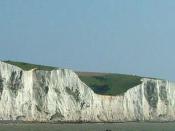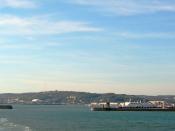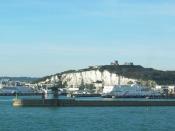One of the most widespread landforms of erosional coasts are sea cliffs. They are found all over the world. Sea cliffs are steep to vertical bedrock that range from a few meters to hundreds of meters in height above sea level. Sea cliffs are the result of wave-induced erosion near sea level and collapsed rocks at higher elevations. One of the most famous of these features is the White Cliffs of Dover on EnglandÃÂs shores.
At some time in the past, the Britain that we know did not exist. It was a western peninsula of the European continent. During the recent Ice Age half a million years ago a large ice sheet spread across northern Britain and large amounts of the North Sea. (National Trust, 2006). This created a huge lake in the chalk hills, which is now the Straits of Dover. The dam of the lake broke, and the water formed a deep channel through the hills.
ÃÂAs the ice melted the sea began to encroach back up this valley eroding away the soft chalk and forming what is now the English Channel-thus Britain became an island.ÃÂ (National Trust, 2006, p 1).
Around 70 million years ago, this part of England was covered by a shallow sea. The bottom of this sea consisted of a white mud formed from the fragments of coccoliths. Coccoliths are the skeletons of microscopic algae, which once lived in the surface waters of the shallow sea. The white mud later became chalk, deposited slowly, at the rate of about half a millimeter a year. (Information Resources, 2006).
The cliffs are still at the mercy of the sea, which eats away at the soft chalk at the base. Approximately two to five centimeters are lost each year to wave action, but even more is lost...


